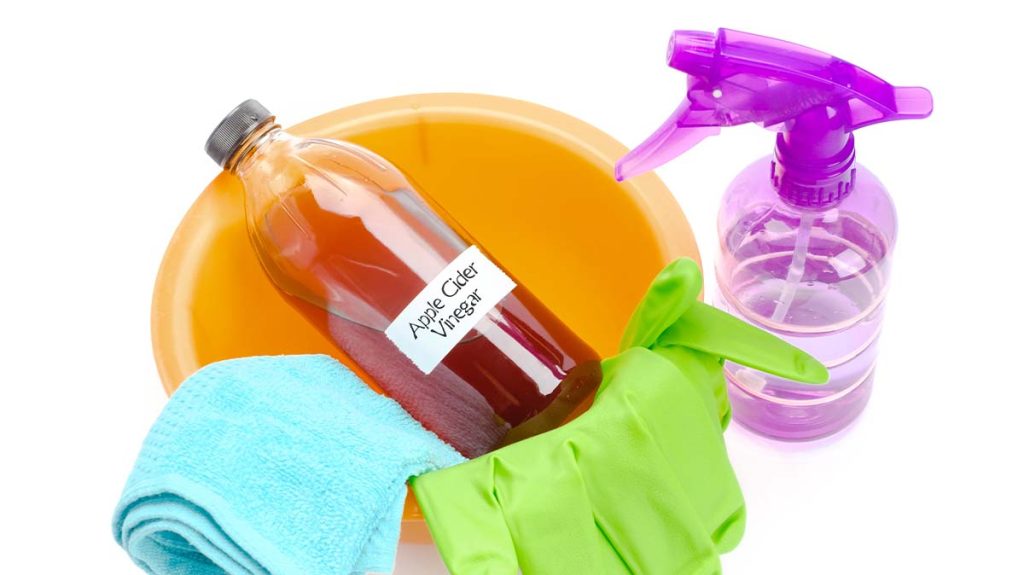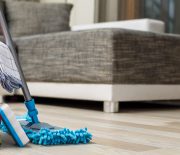
These days, a growing number of folks are steering clear of those eye-watering chemical sprays and reaching instead for gentler, planet-friendly options, like apple cider vinegar (ACV).
What was once a modest regular kitchen cupboard staple has quietly earned its stripes as a go-to hero for eco-minded households everywhere.
But is this multitasker truly up to the job, or is this just another overhyped fad? Continue reading to find out whether cleansing with apple cider vinegar is worth it.
Is apple cider vinegar a good cleaner?
Yes, apple cider vinegar cleaning solutions are extremely effective. Even though it’s just fermented apple juice, this gentle acid works magic, melting away chalky mineral buildup, slicing through sticky grease, and removing persistent grime.
It also battles bacteria and fungi, helping zap those microbes. Better yet, since it’s a green ingredient, it’s safe to use it around pets and children. So, if you want to add an eco-friendly touch to your routine, you should definitely give it a try.
Is it better to clean with white vinegar or apple cider vinegar?
White vinegar has long been a staple in most cleaning caddies, and it’s easy to see why.
It’s clear, has a higher acidity level of around 5‒7%, and tends to be cheaper than its apple-based cousin. That stronger concentration gives it an extra boost against stubborn marks and microbes.
In the showdown between apple cider vinegar vs white vinegar, the latter claims victory.
But don’t write off ACV entirely. It shines when it comes to household maintenance, especially when you want something softer on surfaces or enjoy its subtler aroma. The trick lies in picking what suits your particular situation best.
Cleaning with apple cider vinegar around the house
This cupboard classic isn’t just for salads. From kitchen counters and shower doors to streaky windows and even smelly drains, apple cider vinegar is surprisingly versatile when it comes to regular cleaning.
Here are a few easy ways to use apple cider vinegar cleaning mixes around your house:
1. All‑purpose cleaner
When mixed with water in equal parts, apple cider vinegar creates a mild yet effective solution that’s easy on the wallet and suitable for various surfaces.
While simple, this ranks among the most beloved apple cider vinegar cleaning solutions. It handles any surfaces, kitchen tiles, sinks, and windows remarkably well.
When diluted properly, the acid gently lifts away minor grease, erases pesky fingerprints, and revives dull surfaces nicely.
2. Deodorising with apple cider vinegar
This golden-toned liquid is surprisingly handy when it comes to odours, too. It doesn’t just cover them up; it helps eliminate them completely.
Place a small bowl of it inside the fridge overnight, and by morning, the staleness will have all but vanished.
A quick spritz of apple cider vinegar in musty corners will refresh your living space as well. You can even use it to keep the kitchen bin from wafting yesterday’s dinner every time you open the lid.
Unlike its colourless cousin, its scent doesn’t linger with the same intensity. Once it dries, it usually disappears entirely, leaving nothing but crisp air behind.
3. Cleaning dishwashers and washing machines
When your appliance starts reeking like wet laundry or your glassware comes out dull, it’s time to clean your dishwasher. Dump a cup into a dishwasher-safe container, pop it on the upper rack, and blast through an empty wash on maximum heat.
Your washing machine? Same deal. Pour one or two cups directly into the empty drum, then fire up a hot cycle.
You should be careful, though. You’re still dealing with an acidic agent after all. Constant cleaning with apple cider vinegar can gradually damage those rubber gaskets and seals. That’s why monthly treatments work best. Go overboard and you will find yourself mopping up mystery puddles or wrestling with drainage issues.
4. Easy microwave cleaning with apple cider vinegar steam
You don’t have to spend endless hours scrubbing to wipe down your microwave. A quick steam session will save you a lot of effort and leave the inside of the microwave smelling much better, too.
To clean your microwave with apple cider vinegar, simply combine it with water in a heatproof bowl, pop it in the microwave, and heat it until it steams. Then, leave it inside for ten minutes. This will soften any stuck-on food splatters, making them much easier to wipe away.
If your appliance hasn’t seen the clean end of a towel in a while, a few drops of lemon essential oil will leave it as fresh as a daisy.
5. Can apple cider vinegar descale a coffee maker or kettle?
If your morning brew is starting to taste a little off, your appliance might be due for a wipe. Whether it’s your trusty coffee maker or that well-loved kettle, this toxin-free powerhouse will come to the rescue.
To clean your kettle or coffee pot with apple cider vinegar, simply fill the device halfway with diluted vinegar and run a full cycle in the empty coffee maker or bring the kettle to a boil. Then, let it sit for 15–20 minutes.
Once done, discard the mixture and rinse thoroughly. Then, run one or two plain water cycles afterwards to flush out any lingering scent.
6. Apple cider vinegar for oven cleaning
If your oven is looking a bit tragic but hasn’t quite reached ‘biohazard’ territory, apple cider vinegar is just the low-effort hero you need. It won’t tackle ancient lasagna splatters or prehistoric grease deposits, but it’s perfect for maintenance cleaning between thorough scrubs.
For routine touch-ups, combine equal amounts of this liquid and water in a spray bottle, then target those oily surfaces and dirty nooks. Just avoid spraying anywhere near heating elements unless you want sparks flying.
Let it sit for 10 to 15 minutes, then scrub everything down with a damp cloth or sponge until your oven looks decent again.
You can add a bit of bicarb beforehand as well if you’re dealing with sticky grease. This apple cider vinegar and baking soda eco cleaning mix will lift it all away.
Want to skip the elbow grease?
Book professional oven cleaning and let us tackle the grime for you!
7. Apple cider vinegar for cleaning a toilet
Nobody gets excited about toilet cleaning, but ACV makes the chore bearable. To use apple cider vinegar for cleaning your toilet, pour roughly a cup straight into the bowl.
Let it do its thing for 15-30 minutes or leave it there overnight for deeper action. After that, take your toilet brush, scrub everything down properly, then flush.
As for stubborn rings or hard water stains, sprinkle some bicarb into the bowl first before adding ACV. Let it fizz away for around 30 minutes before giving it a proper scrub.
8. Can apple cider vinegar clean a shower head?
If your once-glorious shower now feels like a leaky faucet, crusty deposits are probably the culprit.
To clean your shower head with apple cider vinegar and get rid of that stubborn grime, you’ll need to yank off the head and plunge it into a container with diluted vinegar. Then, let it soak for an hour or so.
If it’s not removable, simply tie a vinegar-filled bag around it with an elastic band. After enough time has passed, give it a gentle scrub and rinse it thoroughly.
9. Apple cider vinegar for cleaning windows
While the white variety gets top billing for streak-free glass, apple cider vinegar works just as well. To turn your windows from foggy to perfectly transparent, stick with that same 1:1 mixture. Mist the glass well, then polish it dry using a lint-free cloth or wadded-up newspaper.
Nothing fancy about it, but it will leave your windows so spotless you might mistake them for open air.
10. Can you clean floors with apple cider vinegar?
Apple cider vinegar is great for cleaning floors, too. It handles ceramic tiles, linoleum, and vinyl flooring. Simply dump half a cup into a bucket of warm water (roughly 4 litres) and mop as usual.
Dealing with a particularly grimy patch? Go over it several more times, then follow up with plain water to avoid streaks or residual odours.
11. Removing carpet stains
Whether you’ve taken a tumble with your tea or the dog has left you a little ‘surprise package,’ you’ll want to leap into action before the stain makes itself at home.
Want to use apple cider vinegar for carpet cleaning? Mix a splash of apple cider vinegar into some cool water and give the offending patch a light spritz.
Blot it using a cloth or a few sheets of kitchen roll. That should lift most of the mess and stop any blotches from taking hold.
If the mark is still hanging about, sprinkle over a bit of baking soda first and then follow with the vinegar mix.
Once you’ve dabbed away the smudge, go over the rug again with plain water to get rid of any lingering tang. Let it air dry properly, and just like that, it’s as if nothing ever happened.
Some carpets can be rather fussy. To avoid permanent damage, it’s always best to test any DIY mixes on an inconspicuous corner first.
12. Does apple cider vinegar kill mould and mildew?
If you’ve caught those pesky black specks crawling across your shower tiles, mould and mildew have likely set up camp uninvited. Thankfully, this liquid’s natural knack for battling fungi and germs can help you show these unwelcome intruders the door.
To clean mould with apple cider vinegar, just mist it full-strength directly onto the affected zones. Allow it to tackle the grunt work while you take a breather. It’ll work wonders on non-porous surfaces, including tiles, glass screens, or grout.
Let it sit for a while before giving it a good scrub. It won’t magically erase weeks of grime, but it’ll certainly put up a decent fight against minor mould patches and that musty smell they bring along.
That said, you have to keep in mind that it isn’t suitable for porous materials, like drywall or wood, and it doesn’t stand a chance against large-scale infestations.
Surfaces you should never clean with apple cider vinegar
Apple cider vinegar might be the poster child for green cleaning, but it’s not some magical potion that plays nice with everything. If you’re a fan of cleaning with apple cider vinegar, avoid using it on these surfaces:
- Natural stone – This ingredient and natural stone are sworn enemies. That gentle fizz you see on contact? It’s actually your marble or granite being etched into a cloudy mess. Once the shine is gone, there’s no charming it back.
- Hardwood floors – Give ACV enough time, and it’ll quietly strip away that glossy finish you paid so much for. On finished floors, it’ll eat through the top coat. On waxed or unfinished boards, it’s a full-blown attack.
- Aluminium and cast iron – These metals aren’t built to handle apple cider vinegar. An ACV wipe-down can trigger corrosion in aluminium, turning sleek into shabby. Cast iron fares even worse. One splash and you’ll undo years of seasoning.
- Electronics and screens – Even the lightest mist of this ingredient can cause real damage to your devices. It strips away those invisible coatings that keep fingerprints and smudges at bay. Not to mention, circuits and acidity make a terrible pair.
- Rubber seals and gaskets – This liquid doesn’t play nicely with rubber. Use it often enough and you’ll start noticing cracks, stiffness, and a general sense that something’s not quite sealing right.
Your home deserves a bit more sparkle
Book our experts for regular cleaning and bring the shine back!
Takeaways
- Apple cider vinegar is great for most routine household chores.
- It works safely on sealed surfaces, though you should always test a hidden area first.
- Skip using it on natural stone, hardwood flooring, electronics, or metal surfaces.








